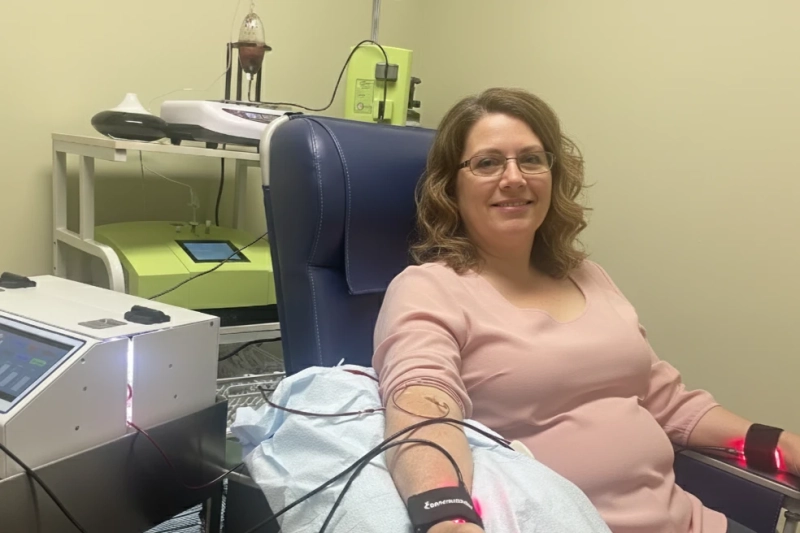When patients hear the terms ozone therapy and EBOO therapy, they often mistake the two as being identical. The assumption is understandable: both involve the medical use of ozone.
However, this is only part of the picture. While ozone therapy is well-recognized for its immune-modulating and oxygen-enhancing properties, EBOO (Extracorporeal Blood Oxygenation and Ozonation) takes treatment further by combining ozone with an advanced blood-filtration process.
This distinction is crucial, not only for patients seeking clarity but also for ensuring they receive the therapy that best aligns with their health goals.
What Is Ozone Therapy?
Ozone therapy, sometimes called “other ozone” therapy to distinguish it from EBOO, involves the administration of ozone (O₃)—a molecule made of three oxygen atoms—into the body.
This can be done through different routes such as intravenous (autohemotherapy), insufflation, or topical application.
From a physiological standpoint, ozone therapy works by:
- Modulating oxidative stress: Stimulates controlled oxidative reactions that trigger antioxidant responses in the body.
- Improving circulation: Enhances red blood cell flexibility and oxygen delivery to tissues.
- Supporting immune defense: Activates white blood cells, helping fight pathogens.
- Reducing inflammation: Influences cytokine signaling pathways to calm chronic inflammation.
Patients often turn to ozone therapy for chronic fatigue, immune weakness, infections, and general wellness. It’s a well-studied therapy in integrative medicine, but it remains distinct from EBOO.
What Is EBOO Therapy?
EBOO, or Extracorporeal Blood Oxygenation and Ozonation, is best described as an advanced evolution of ozone therapy. Instead of simply exposing blood to ozone, EBOO passes the blood through a sophisticated extracorporeal circuit—similar in concept to dialysis.
Here’s the step-by-step process:
- A portion of the patient’s blood is withdrawn and circulated outside the body.
- The blood flows through a specialized filter, which removes metabolic waste products, heavy metals, and pathogenic debris.
- While undergoing filtration, the blood is simultaneously oxygenated and ozonated, saturating it with oxygen-rich and ozone-reactive molecules.
- The revitalized and detoxified blood is returned to the patient’s circulation.
This dual-action mechanism—detoxification plus oxygen/ozone enrichment—is what elevates EBOO above conventional ozone therapies.
EBOO vs. Ozone Therapy: Key Distinctions
To appreciate why the two should not be confused, it’s helpful to look at them side by side:

Why Patients Often Get Confused
The confusion between EBOO and ozone therapy arises for several reasons:
- Both therapies incorporate ozone as a therapeutic agent.
- Clinics and media often present ozone-based treatments under the same category.
- Patients searching online encounter overlapping terminology, leading to misconceptions.
But the truth is straightforward: EBOO is not “just ozone.” Its filtration step sets it apart, making it a more comprehensive and systemic approach.
The Scientific Edge of EBOO
From a biomedical perspective, EBOO offers unique physiological benefits:
- Advanced detoxification: The filtration process removes circulating toxins and pathogenic byproducts, reducing overall oxidative burden.
- Systemic oxygenation: By saturating red blood cells with oxygen and ozone, EBOO enhances mitochondrial energy production.
- Immune recalibration: Similar to ozone therapy, EBOO influences immune modulation but with an added systemic “reset” due to reduced toxic load.
- Inflammatory balance: Evidence suggests EBOO may downregulate pro-inflammatory markers more effectively than ozone alone.
These combined effects make EBOO especially relevant for chronic illnesses, autoimmune conditions, cardiovascular dysfunction, and complex cases where standard ozone therapy may provide only partial benefit.
Why EBOO Is Considered the Premium Option
Patients should view EBOO as the next generation of ozone-based therapy. It is more resource-intensive, requires advanced equipment, and is performed under greater clinical oversight. But those factors are exactly what make it the premium choice.
In essence:
- Ozone therapy = beneficial oxygenation.
- EBOO therapy = oxygenation + detoxification + deeper systemic repair.
For patients dealing with complex or chronic conditions, the difference is not minor—it’s potentially life-changing.
Final Takeaway
It’s time to eliminate the confusion: EBOO and ozone therapy are not the same.
While ozone therapy offers valuable wellness and immune benefits, EBOO represents a comprehensive, advanced approach by integrating ozone with extracorporeal blood filtration.
Think of ozone therapy as a solid foundation—and EBOO as the advanced architecture built on top. Both have value, but their scope and depth of impact differ significantly.
FAQs About EBOO and Ozone Therapy
Q1. Does EBOO therapy include ozone therapy?
Yes. EBOO uses ozone as part of its process but adds a filtration step, making it more advanced than standard ozone therapy.
Q2. Can I replace ozone therapy with EBOO?
Not necessarily. Both therapies have unique applications. Ozone therapy may be enough for general wellness, while EBOO is often reserved for chronic or complex conditions.
Q3. Is EBOO safe?
Yes, when performed in a qualified clinical setting. Like ozone therapy, it is considered safe, though EBOO requires more sophisticated equipment and expertise.
Q4. Who benefits most from EBOO?
Patients with chronic inflammation, autoimmune disorders, cardiovascular issues, or heavy toxin load may see the greatest benefit from EBOO.
Q5. Why is EBOO considered “premium”?
Because it combines multiple therapeutic mechanisms—filtration, oxygenation, and ozonation—resulting in a deeper systemic effect than ozone therapy alone.



